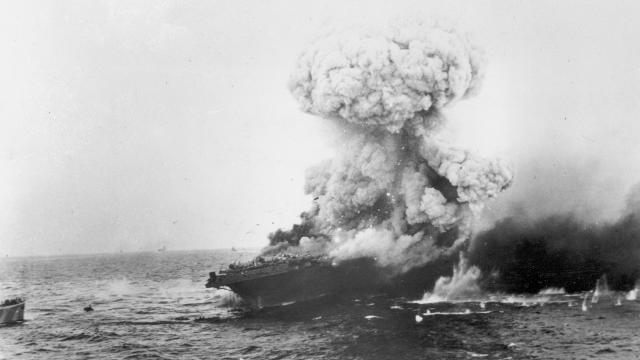The USS Lexington, a US aircraft carrier lost during the 1942 Battle of the Coral Sea, has been discovered by a team of civilian researchers off the north-east coast of Australia.
The USS Lexington explodes after being bombed by Japanese planes in the Battle of the Coral Sea in the South Pacific in June 1942, during World War II. Photo: Associated Press
The Lexington was discovered on Sunday, March 4, by Vulcan Inc., a company chaired by Microsoft cofounder Paul Allen. A search team aboard the Research Vessel (R/V) Petrel found the ship – one of the United States’ first aircraft carriers – about 800km from the Australian east coast, and at a depth of 3km. The ship went down in May 1942 after a four-day battle against three Japanese aircraft carriers.
Using a remotely operated sub, the Vulcan team was able to locate the ship’s nameplate, confirming its identity. The ship was found split up into three main pieces, its main section lying upright. The bow and stern section were found about 1.6km away. Photos of the wreck show the severed ship in exquisite detail, including some anti-aircraft cannons.
To the west, the team found 11 of the 35 planes that went down with the ship, including seven Douglas TBD-1 Devastators, three Douglas SBD-3 Dauntlesses and a lone Grumman F4F-3 Wildcat. These planes are in remarkably good shape, with the five-pointed star insignia of the US Army Air Forces clearly visible on the wings and fuselage. One plane was adorned with Felix the Cat and four miniature Imperial Japanese flags, indicating kills.
“Lady Lex” went down with 35 planes. So far, #RVPetrel has found 11 of them. Here’s a look at two Douglas TBD-1 Devastators, resting on top of each other, and a close up of a Grumman F4F-3 Wildcat. https://t.co/19CuqvopwB pic.twitter.com/FEWZYD0iEo
— Paul Allen (@PaulGAllen) March 6, 2018
The USS Lexington, or “Lady Lex”, as it was nicknamed, fought alongside another US aircraft carrier, the USS Yorktown, during the Battle of the Coral Sea, which lasted from 4 to 8 May 1942. Together, these ships fought three Japanese aircraft carriers, the Shōkaku, Zuikaku and Shōhō, the latter of which went down during the battle. On May 8, the Lexington was badly damaged by torpedoes and enemy planes, and the ship was deliberately sunk to prevent capture. Some 2735 sailors were rescued, but 216 crewmen were killed during the battle. The engagement marked the first carrier-on-carrier battle in naval history, signifying a new type of naval warfare.
The Lexington won’t be salvaged, as it’s protected under the US Sunken Military Craft Act, which designates it a war grave.
“As the son of a survivor of the USS Lexington, I offer my congratulations to Paul Allen and the expedition crew of Research Vessel (R/V) Petrel for locating the ‘Lady Lex’, sunk nearly 76 years ago at the Battle of Coral Sea,” Admiral Harry Harris, chief of US military’s Pacific Command, said in a statement. “We honour the valor and sacrifice of the ‘Lady Lex’s’ Sailors – and all those Americans who fought in World War II – by continuing to secure the freedoms they won for all of us.”

The USS Lexington in 1941. Photo: National Archives
A spokesperson for Vulcan said it had taken about six months of planning to locate the ship, and that it was a high priority target for the company. Last year, the company found the USS Indianapolis, which sunk in July 1945.
